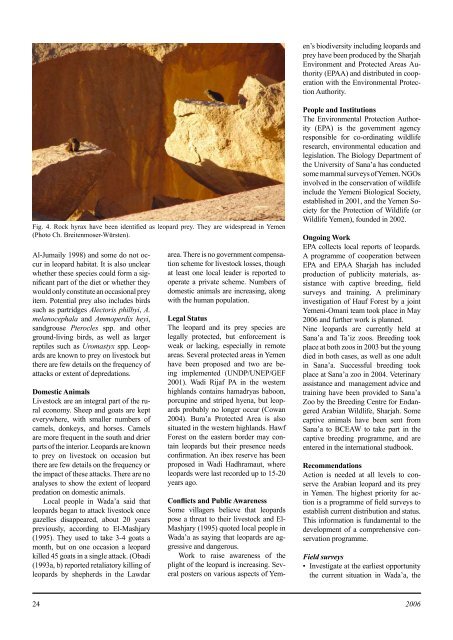Status and Conservation of the Leopard on the ... - Nwrc.gov.sa
Status and Conservation of the Leopard on the ... - Nwrc.gov.sa
Status and Conservation of the Leopard on the ... - Nwrc.gov.sa
Create successful ePaper yourself
Turn your PDF publications into a flip-book with our unique Google optimized e-Paper software.
C<strong>on</strong>flicts <str<strong>on</strong>g>and</str<strong>on</strong>g> Public Awareness<br />
Some villagers believe that leopards<br />
pose a threat to <str<strong>on</strong>g>the</str<strong>on</strong>g>ir livestock <str<strong>on</strong>g>and</str<strong>on</strong>g> El-<br />
Mashjary (1995) quoted local people in<br />
Wada’a as <strong>sa</strong>ying that leopards are aggressive<br />
<str<strong>on</strong>g>and</str<strong>on</strong>g> dangerous.<br />
Work to raise awareness <str<strong>on</strong>g>of</str<strong>on</strong>g> <str<strong>on</strong>g>the</str<strong>on</strong>g><br />
plight <str<strong>on</strong>g>of</str<strong>on</strong>g> <str<strong>on</strong>g>the</str<strong>on</strong>g> leopard is increasing. Several<br />
posters <strong>on</strong> various aspects <str<strong>on</strong>g>of</str<strong>on</strong>g> Yemen’s<br />
biodiversity including leopards <str<strong>on</strong>g>and</str<strong>on</strong>g><br />
prey have been produced by <str<strong>on</strong>g>the</str<strong>on</strong>g> Sharjah<br />
Envir<strong>on</strong>ment <str<strong>on</strong>g>and</str<strong>on</strong>g> Protected Areas Authority<br />
(EPAA) <str<strong>on</strong>g>and</str<strong>on</strong>g> distributed in cooperati<strong>on</strong><br />
with <str<strong>on</strong>g>the</str<strong>on</strong>g> Envir<strong>on</strong>mental Protecti<strong>on</strong><br />
Authority.<br />
Fig. 4. Rock hyrax have been identified as leopard prey. They are widespread in Yemen<br />
(Photo Ch. Breitenmoser-Würsten).<br />
Al-Jumaily 1998) <str<strong>on</strong>g>and</str<strong>on</strong>g> some do not occur<br />
in leopard habitat. It is also unclear<br />
whe<str<strong>on</strong>g>the</str<strong>on</strong>g>r <str<strong>on</strong>g>the</str<strong>on</strong>g>se species could form a significant<br />
part <str<strong>on</strong>g>of</str<strong>on</strong>g> <str<strong>on</strong>g>the</str<strong>on</strong>g> diet or whe<str<strong>on</strong>g>the</str<strong>on</strong>g>r <str<strong>on</strong>g>the</str<strong>on</strong>g>y<br />
would <strong>on</strong>ly c<strong>on</strong>stitute an occasi<strong>on</strong>al prey<br />
item. Potential prey also includes birds<br />
such as partridges Alectoris philbyi, A.<br />
melanocephala <str<strong>on</strong>g>and</str<strong>on</strong>g> Ammoperdix heyi,<br />
s<str<strong>on</strong>g>and</str<strong>on</strong>g>grouse Pterocles spp. <str<strong>on</strong>g>and</str<strong>on</strong>g> o<str<strong>on</strong>g>the</str<strong>on</strong>g>r<br />
ground-living birds, as well as larger<br />
reptiles such as Uromastyx spp. <str<strong>on</strong>g>Leopard</str<strong>on</strong>g>s<br />
are known to prey <strong>on</strong> livestock but<br />
<str<strong>on</strong>g>the</str<strong>on</strong>g>re are few details <strong>on</strong> <str<strong>on</strong>g>the</str<strong>on</strong>g> frequency <str<strong>on</strong>g>of</str<strong>on</strong>g><br />
attacks or extent <str<strong>on</strong>g>of</str<strong>on</strong>g> depredati<strong>on</strong>s.<br />
Domestic Animals<br />
Livestock are an integral part <str<strong>on</strong>g>of</str<strong>on</strong>g> <str<strong>on</strong>g>the</str<strong>on</strong>g> rural<br />
ec<strong>on</strong>omy. Sheep <str<strong>on</strong>g>and</str<strong>on</strong>g> goats are kept<br />
everywhere, with smaller numbers <str<strong>on</strong>g>of</str<strong>on</strong>g><br />
camels, d<strong>on</strong>keys, <str<strong>on</strong>g>and</str<strong>on</strong>g> horses. Camels<br />
are more frequent in <str<strong>on</strong>g>the</str<strong>on</strong>g> south <str<strong>on</strong>g>and</str<strong>on</strong>g> drier<br />
parts <str<strong>on</strong>g>of</str<strong>on</strong>g> <str<strong>on</strong>g>the</str<strong>on</strong>g> interior. <str<strong>on</strong>g>Leopard</str<strong>on</strong>g>s are known<br />
to prey <strong>on</strong> livestock <strong>on</strong> occasi<strong>on</strong> but<br />
<str<strong>on</strong>g>the</str<strong>on</strong>g>re are few details <strong>on</strong> <str<strong>on</strong>g>the</str<strong>on</strong>g> frequency or<br />
<str<strong>on</strong>g>the</str<strong>on</strong>g> impact <str<strong>on</strong>g>of</str<strong>on</strong>g> <str<strong>on</strong>g>the</str<strong>on</strong>g>se attacks. There are no<br />
analyses to show <str<strong>on</strong>g>the</str<strong>on</strong>g> extent <str<strong>on</strong>g>of</str<strong>on</strong>g> leopard<br />
predati<strong>on</strong> <strong>on</strong> domestic animals.<br />
Local people in Wada’a <strong>sa</strong>id that<br />
leopards began to attack livestock <strong>on</strong>ce<br />
gazelles di<strong>sa</strong>ppeared, about 20 years<br />
previously, according to El-Mashjary<br />
(1995). They used to take 3-4 goats a<br />
m<strong>on</strong>th, but <strong>on</strong> <strong>on</strong>e occasi<strong>on</strong> a leopard<br />
killed 45 goats in a single attack. (Obadi<br />
(1993a, b) reported retaliatory killing <str<strong>on</strong>g>of</str<strong>on</strong>g><br />
leopards by shepherds in <str<strong>on</strong>g>the</str<strong>on</strong>g> Lawdar<br />
area. There is no <strong>gov</strong>ernment compen<strong>sa</strong>ti<strong>on</strong><br />
scheme for livestock losses, though<br />
at least <strong>on</strong>e local leader is reported to<br />
operate a private scheme. Numbers <str<strong>on</strong>g>of</str<strong>on</strong>g><br />
domestic animals are increasing, al<strong>on</strong>g<br />
with <str<strong>on</strong>g>the</str<strong>on</strong>g> human populati<strong>on</strong>.<br />
Legal <str<strong>on</strong>g>Status</str<strong>on</strong>g><br />
The leopard <str<strong>on</strong>g>and</str<strong>on</strong>g> its prey species are<br />
legally protected, but enforcement is<br />
weak or lacking, especially in remote<br />
areas. Several protected areas in Yemen<br />
have been proposed <str<strong>on</strong>g>and</str<strong>on</strong>g> two are being<br />
implemented (UNDP/UNEP/GEF<br />
2001). Wadi Rijaf PA in <str<strong>on</strong>g>the</str<strong>on</strong>g> western<br />
highl<str<strong>on</strong>g>and</str<strong>on</strong>g>s c<strong>on</strong>tains hamadryas babo<strong>on</strong>,<br />
porcupine <str<strong>on</strong>g>and</str<strong>on</strong>g> striped hyena, but leopards<br />
probably no l<strong>on</strong>ger occur (Cowan<br />
2004). Bura’a Protected Area is also<br />
situated in <str<strong>on</strong>g>the</str<strong>on</strong>g> western highl<str<strong>on</strong>g>and</str<strong>on</strong>g>s. Hawf<br />
Forest <strong>on</strong> <str<strong>on</strong>g>the</str<strong>on</strong>g> eastern border may c<strong>on</strong>tain<br />
leopards but <str<strong>on</strong>g>the</str<strong>on</strong>g>ir presence needs<br />
c<strong>on</strong>firmati<strong>on</strong>. An ibex reserve has been<br />
proposed in Wadi Hadhramaut, where<br />
leopards were last recorded up to 15-20<br />
years ago.<br />
People <str<strong>on</strong>g>and</str<strong>on</strong>g> Instituti<strong>on</strong>s<br />
The Envir<strong>on</strong>mental Protecti<strong>on</strong> Authority<br />
(EPA) is <str<strong>on</strong>g>the</str<strong>on</strong>g> <strong>gov</strong>ernment agency<br />
resp<strong>on</strong>sible for co-ordinating wildlife<br />
research, envir<strong>on</strong>mental educati<strong>on</strong> <str<strong>on</strong>g>and</str<strong>on</strong>g><br />
legislati<strong>on</strong>. The Biology Department <str<strong>on</strong>g>of</str<strong>on</strong>g><br />
<str<strong>on</strong>g>the</str<strong>on</strong>g> University <str<strong>on</strong>g>of</str<strong>on</strong>g> Sana’a has c<strong>on</strong>ducted<br />
some mammal surveys <str<strong>on</strong>g>of</str<strong>on</strong>g> Yemen. NGOs<br />
involved in <str<strong>on</strong>g>the</str<strong>on</strong>g> c<strong>on</strong>servati<strong>on</strong> <str<strong>on</strong>g>of</str<strong>on</strong>g> wildlife<br />
include <str<strong>on</strong>g>the</str<strong>on</strong>g> Yemeni Biological Society,<br />
established in 2001, <str<strong>on</strong>g>and</str<strong>on</strong>g> <str<strong>on</strong>g>the</str<strong>on</strong>g> Yemen Society<br />
for <str<strong>on</strong>g>the</str<strong>on</strong>g> Protecti<strong>on</strong> <str<strong>on</strong>g>of</str<strong>on</strong>g> Wildlife (or<br />
Wildlife Yemen), founded in 2002.<br />
Ongoing Work<br />
EPA collects local reports <str<strong>on</strong>g>of</str<strong>on</strong>g> leopards.<br />
A programme <str<strong>on</strong>g>of</str<strong>on</strong>g> cooperati<strong>on</strong> between<br />
EPA <str<strong>on</strong>g>and</str<strong>on</strong>g> EPAA Sharjah has included<br />
producti<strong>on</strong> <str<strong>on</strong>g>of</str<strong>on</strong>g> publicity materials, assistance<br />
with captive breeding, field<br />
surveys <str<strong>on</strong>g>and</str<strong>on</strong>g> training. A preliminary<br />
investigati<strong>on</strong> <str<strong>on</strong>g>of</str<strong>on</strong>g> Hauf Forest by a joint<br />
Yemeni-Omani team took place in May<br />
2006 <str<strong>on</strong>g>and</str<strong>on</strong>g> fur<str<strong>on</strong>g>the</str<strong>on</strong>g>r work is planned.<br />
Nine leopards are currently held at<br />
Sana’a <str<strong>on</strong>g>and</str<strong>on</strong>g> Ta’iz zoos. Breeding took<br />
place at both zoos in 2003 but <str<strong>on</strong>g>the</str<strong>on</strong>g> young<br />
died in both cases, as well as <strong>on</strong>e adult<br />
in Sana’a. Successful breeding took<br />
place at Sana’a zoo in 2004. Veterinary<br />
assistance <str<strong>on</strong>g>and</str<strong>on</strong>g> management advice <str<strong>on</strong>g>and</str<strong>on</strong>g><br />
training have been provided to Sana’a<br />
Zoo by <str<strong>on</strong>g>the</str<strong>on</strong>g> Breeding Centre for Endangered<br />
Arabian Wildlife, Sharjah. Some<br />
captive animals have been sent from<br />
Sana’a to BCEAW to take part in <str<strong>on</strong>g>the</str<strong>on</strong>g><br />
captive breeding programme, <str<strong>on</strong>g>and</str<strong>on</strong>g> are<br />
entered in <str<strong>on</strong>g>the</str<strong>on</strong>g> internati<strong>on</strong>al studbook.<br />
Recommendati<strong>on</strong>s<br />
Acti<strong>on</strong> is needed at all levels to c<strong>on</strong>serve<br />
<str<strong>on</strong>g>the</str<strong>on</strong>g> Arabian leopard <str<strong>on</strong>g>and</str<strong>on</strong>g> its prey<br />
in Yemen. The highest priority for acti<strong>on</strong><br />
is a programme <str<strong>on</strong>g>of</str<strong>on</strong>g> field surveys to<br />
establish current distributi<strong>on</strong> <str<strong>on</strong>g>and</str<strong>on</strong>g> status.<br />
This informati<strong>on</strong> is fundamental to <str<strong>on</strong>g>the</str<strong>on</strong>g><br />
development <str<strong>on</strong>g>of</str<strong>on</strong>g> a comprehensive c<strong>on</strong>servati<strong>on</strong><br />
programme.<br />
Field surveys<br />
• Investigate at <str<strong>on</strong>g>the</str<strong>on</strong>g> earliest opportunity<br />
<str<strong>on</strong>g>the</str<strong>on</strong>g> current situati<strong>on</strong> in Wada’a, <str<strong>on</strong>g>the</str<strong>on</strong>g><br />
24 2006
















